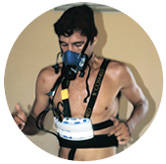Obesity
It is defined as the excess of accumulated body fat; it usually starts during childhood which increases 3 times the probabilities to become an obese adult. Obesity is not only associated with artery hypertension, mellitus diabetes, dislepidemies and cardiovascular diseases but also to the related psychological factors such as a low self-esteem, discrimination, mocks and very little interest on physical activities.
Even though the relationship between obesity, health and diseases has not been clearly established yet, epidemiological research shows that obesity is associated to an increase in adult mortality and is an important risk factor for hypertension, diabetes, and coronary cardiopathy.
The body fat distribution is an important factor to consider; as it is the android obesity, typical from men and pos-menopausal women, which is associated to obesity’s metabolic complications. In Framingham’s survey it was concluded that if a person is in its optimum weight, it has % less probabilities of presenting coronary illness and a% less probabilities of presenting heart failure and encephalic vascular faint. (obesity).
The obesity profile in Chile is particularly alarming, since it shows a fast increase in the last years; in 1992 a survey found 20.7% in men and 34.4% in women; the social-economical level plays an important role, there is more obesity in women of a low social-economical level and in men of a medium social economical level. (Rozowski, Arteaga, 1996)
For the body fat to increase , it is required a positive energetic balance, which can be due to a bigger ingestion and/or to a minor consumption. In this context, the group that presents more obesity, is where a sedentary lifestyle prevails (90.5%) and it corresponds to the group of women. (Rozowski and Arteaga).
Exercise and Health
In our country, the main death cause are cardiovascular illnesses, with 29% total of deaths, which higher percentage is 35-74 years old, where men have rates twice as high as women.
Out of all the factors that affect this pathology positively, such as quitting smoking controlling weight and improving nutrition factors; physical activity has been described as the control that most affects the lifestyle change and prevention of cardiovascular risk factors. (Raffo and Venegas 1997).
Evidences given by surveys done in developed countries, conclude that regular physical activity can help to prevent and correct obesity, even when the obese individual does not reach a normal nutritional state. (Albala, Diaz and Uauy).
|
|
The time spent in doing physical activity is inversely correlated to the accumulated fat level, and this has to do with the use of the energetic substratum depending on the duration and intensity of an exercise. This way in the 1E hour of a light to moderate intensity exercise (between 40 and 60% of max VO2), lipids contribute with 50% of the energetic sources, in the3E hour, fat contributes with 70%, that is to say the longest the exercise, the highest consumption of fat. |
Another factor to do a useful physical activity from obesity’s point of view is the intensity of an exercise, the light to moderate intensity exercise is the one that uses the fatty acids of plasma liberated from the fatty deposits. Thereby the training in these intensity levels has a deep effect over lipids’ metabolism increasing the liberation and usage of fats.
Dislipidemy and Exercise
The android obesity frequently coexists with other metabolic disorders, such as hyperinsulinemy, glucose intolerance and hypertrigliceridemy ( these four factors are known as the quartet of death or X syndrome), it is also associated to low HDL cholesterol. (HA technical norms)
Handling this syndrome means to handle obesity in an appropriate way, it is known that the abdominal adipose cells are more metabolically active and will respond faster to amore balanced nourishment and exercise. Aerobic exercise has a triple action: to promote the weight loss, to increase the HDL cholesterol level and to reduce hyperinsulinemy.
The HDL cholesterol, called "good cholesterol", due to its protective effect makes a reverse transportation of cholesterol from the arterial lumen to the liver, where it is incorporated and excreted by the bile. Higher values have been found in resistance athletes, and there is agreement on exercising provoking metabolic changes that supply a higher substratum for the HDL cholesterol formation. (Mc Ardle,1996)
